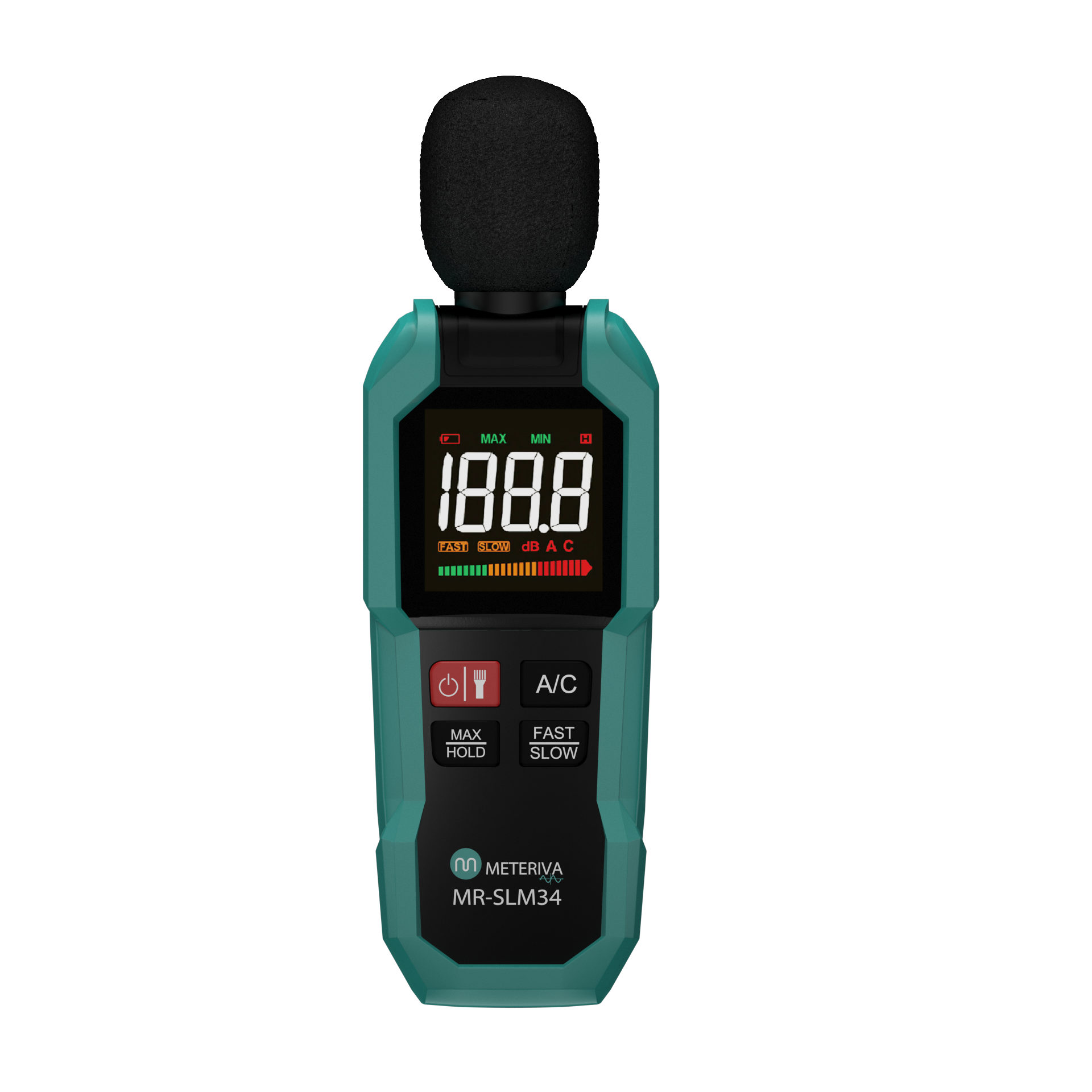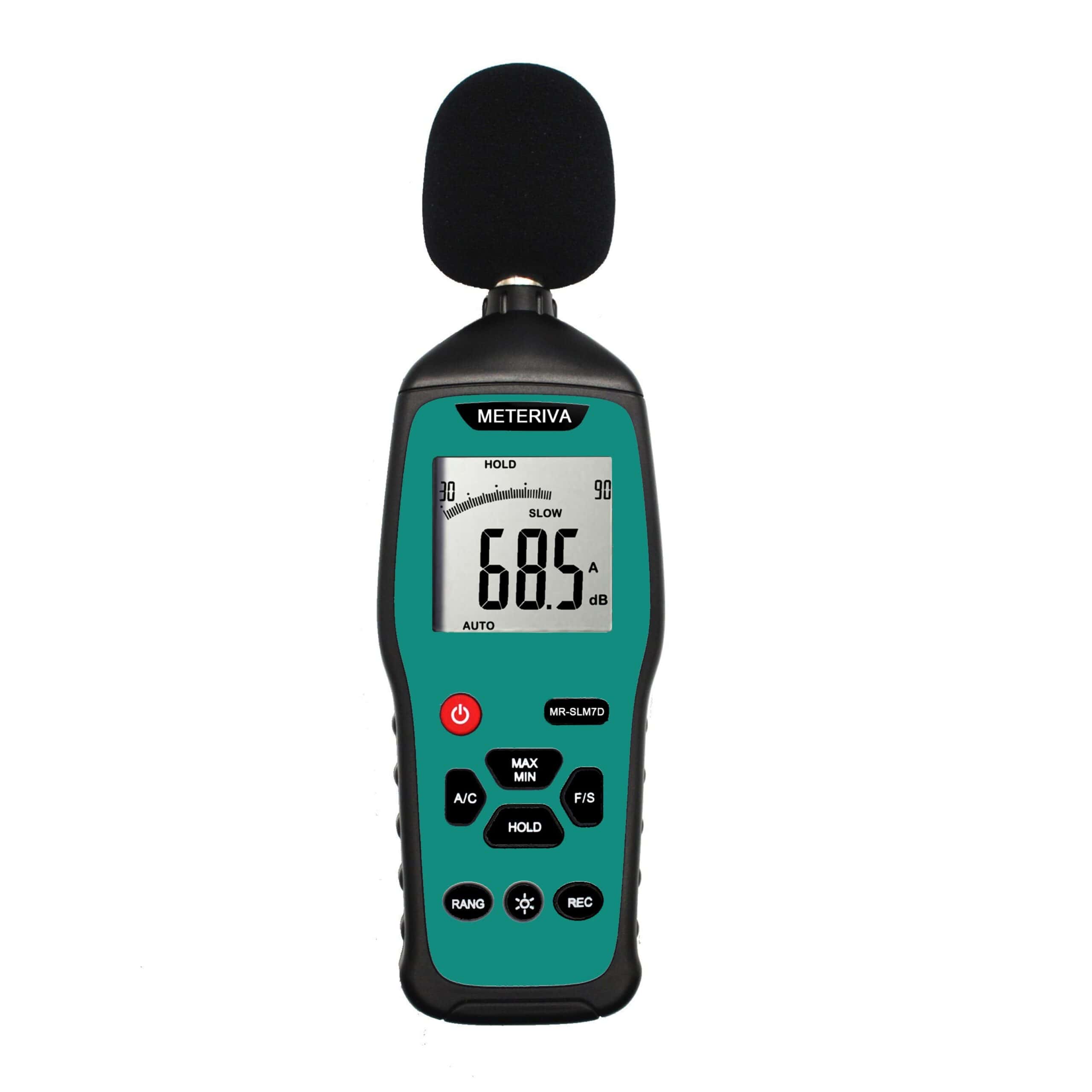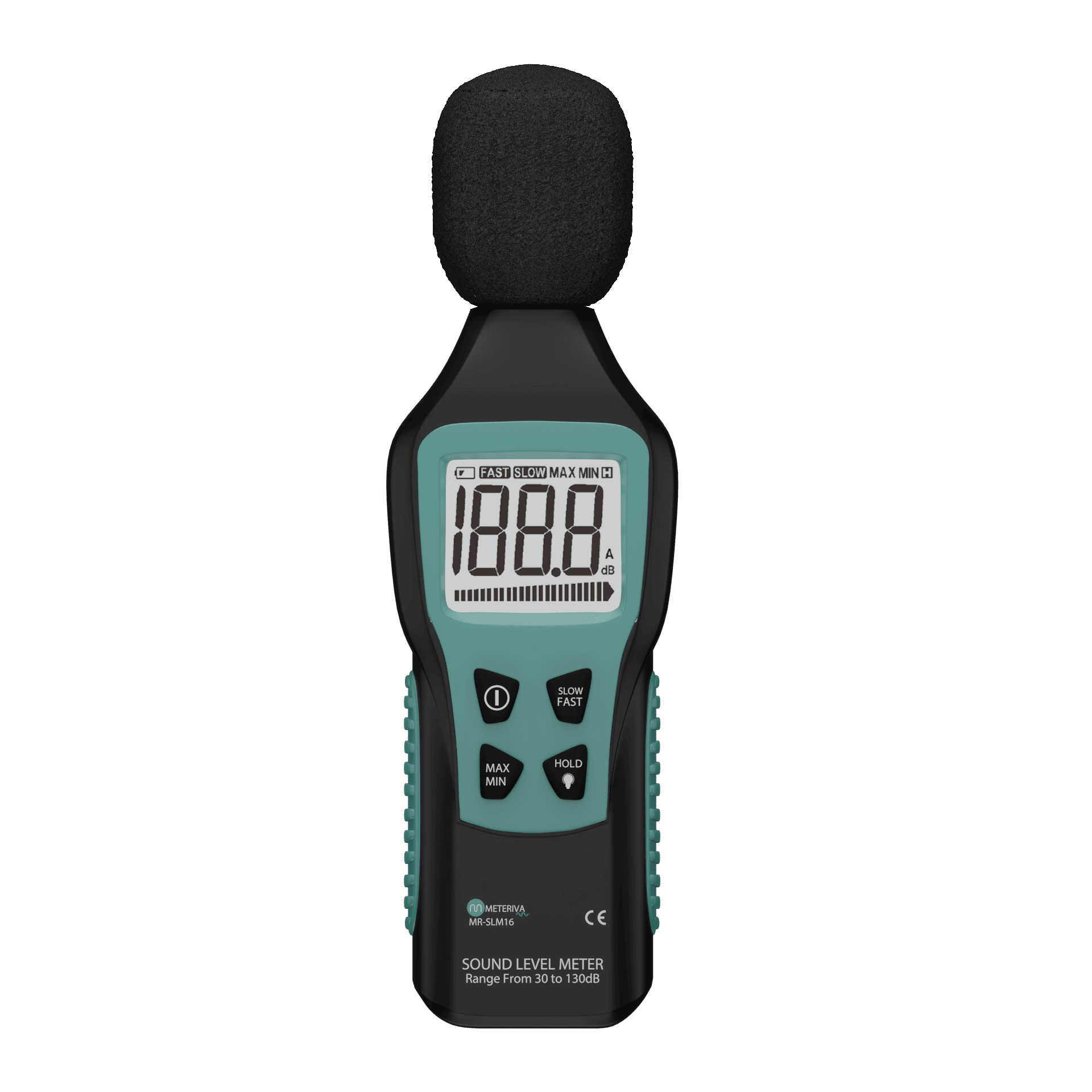Sound Level Meter
METERIVA Sound Level Meter
A sound level meter is an instrument that is used to gauge the level of sounds and noise as per sound pressure and its measurement. The other names for these instrument is decibel or noise meters, noise dosimeter or sound pressure level (SPL) meter. This machine measures the level of the sounds by recording and capturing the sound through microphone and then assesses this sound in the meter. The acoustic measurements are generally presented in decibels (dB); some meters also provide the equivalent continuous sound level (Leq) and other parameters.
Sound Level Meter In Use
Purchase Advice on Sound Level Meter
Since these are portable devices, the sound level meter use at different locations may be checked by a single safety professional so that, they fall within the recommended exposure limits (RELs). A few can be permanently fixed to provide continuous monitoring for constant periods. While choosing a sound level meter device, its type or class, which indicates its accuracy according to ANSI or IEC standard should be taken into consideration. Class 1 meters are for high-precision assessments usually considered suitable for laboratories. Type 2/class 2 meters are sufficient for assessing noise in simple settings such as industries, schools or homes.
Using a Sound Level Meter
When one is using a sound level meter to assess or categorize environmental or traffic noise, then a precise equipment is needed. Naturally, the used sound level meter device should be at least a class II type and calibrated. However, what is actually important is to minimize interference from the surroundings so that repeatable results can be reported.
Various factors that influence the sound measurements
1. The Operator:
Touching the casing of a sound level meter may generate the noise that affects the resultant measurement. Besides, the noise can result from the dressing of the operator. Sometimes, the body can provide a perfect surface for sound reflection. Ideally, the housing of a sound level meter should be conical, from the microphone point to avoid such sound reflections.
To the extent possible, one should always set up the sound level meter on a tripod so that the operator has the freedom to move behind whenever necessary in order to get accurate readings. If one has to measure a distance level, then an extension cable for the microphone should be used by the operator. Modern sound level meters come with a feature of data logging. Hence, taking measurements from the site without an operator becomes easy. The sound level meter comes with a possibility to preset all necessary parameters.
2. Wind & Humidity:
To minimize the impact of wind or airflow on sound readings, current sound level meters come with a foam ball or sponge surrounding the microphone. The foam ball therefore, acts not only as a wind screen, but it protects the microphone from any dust or small moisture particles. This becomes particularly important when trying to measure noise from an area that has humidity levels up to 80% and above.
The high level of humidity can affect the quality of the microphone. There are outdoor kits also available for checking and doing measurements in a highly humid or dusty environment. These kits offer special protective measures for the sound level meter and the microphone during outdoor measurements. The sound level meter price similarly varies depending on the type and features of the device
3. Temperature & Pressure:
Each sound level meter is provided with a technical specification that gives the maximum temperature details under which the device can operate. High temperatures, as any measuring instrument, can damage the internal circuits. But the main concern is to prevent any sudden temperature changes leading to condensation that can hamper the microphone. Another minor source of sound measurement errors is the surrounding pressure that may affect the sensitivity of the microphone. However, for this to happen, the pressure changes must be significant (around ±200 mbar).
4. Vibrations:
An anti-vibration or the feet of the tripod may better be used if you have to use a sound level meter where sources of vibrations are found. This can go a long way in ensuring that more reliable results are acquired. Taking this into consideration, much more consistent results can be obtained with the sound level meter use. For specific sound measurements, such as assessing people’s sound exposure or taking measurements on noise barriers one may need to adhere to certain ISO standards:
- General standards: IEC 651 and ANSI S1.4
- Sound affecting humans: ISO 2204
- Noise in workplaces: ISO 9612
Few other important considerations are outlined as under:
Double Loudness:
Decibel (dB) is a standard unit for measuring sounds levels. Although the conventional standard rule of doubling would not apply during sound levels evaluation in places such as workplaces. Human hearing threshold is 0 dB, but that does not mean it could be doubled.
When a rule says that noise should not be more than 50 dB, the rise by 10-15 dB is an unimportant increase as it might seem. This is very far from the double value (100), but in fact, this is even a substantial change. Loudness or ‘volume’ doubles with each extra 10 dB in acoustic terms (indeed, power doubles every 3 dB, and the actual acoustic pressure doubles every 6 dB). This is what one should recall upon interpreting the levels of these sounds.
Sound Level Meter Calibrations:
Most of the modern devices including sound or noise level meters are available with optimal & proper calibration. Unlike earlier situations where the instruments had to be frequently calibrated for improved precision and stability. However, instances of damages particularly to delicate parts such microphone may arise leading to a need of calibration. Class 1 sound level meters are meant for making the most precise measurements; such as the reference standards. The main use of a class 2 meter is for compliance testing within work premises.
Calibration involves setting the measuring magnitudes of an instrument in order to ascertain & analyse its capabilities. This allows the calibration to be carried out without interfering with the measuring system. It also does not determine or check the systematic deviation of the display from the true measuring magnitude. A certificate of calibration verifies that a test instrument guarantees its recognized measurement standard’s technical characteristics. We can check the sound level meter price online for different types of meters. The noise level measuring device and its application in various fields have made it a crucial tool in today’s world. We can easily find a sound level meter online.
Outdoor Noise & Measurement:
In today’s urban environments, silence seems to be a luxury, hardly available in public spaces. Noise from people, vehicles, equipment and the layout or setting of an establishment contributes to noise pollution. Therefore, it has become quite important to manage such noises as it harms human health and life significantly. It is customary for people staying adjacent to some busy area like airports, railway stations, or hospitals to always have complaints of high noise in their vicinity. If a person listens to such loud noises for a long period of time, he is likely to suffer from hearing loss, increased anxiety, irritability and other psychological ailments.
Therefore, it becomes necessary to monitor and control noise levels using a sound level meter in different places. Noise levels ranging between 120 dB to 150 dB, such as the sound of airplanes taking off, road construction etc. can be harmful to human hearing. The desired and ideal noise levels are between 30 dB to 50 dB. However, achieving such levels is quite demanding in modern society. The severity of noise exposure cannot be determined by perception alone; it requires physical measurements like using a sound level meter.
Verifiable Sound Meters:
The International Electrotechnical Commission (IEC) identifies two classes of sound level meters, Class I and Class II. In some other sources however, the descriptions are available for even four kinds of sound level meters, such as Type 0, Type 1, Type 2, and Type 3. The Type 0 meters are generally used as laboratory equipment meant for setting references for other meters and are also used in their calibration.
While not as accurate as other meters, the Type 0 meters are usually not a preferred choice for routine measurements. Class I/Type 1 meters, nearly as precise as laboratory equipment, are considered ideal for checking hygiene conditions in different workplaces or environment concerning human health. It has a broad frequency range with minimal measurement error, making them suitable for detailed environmental analysis. Class II/Type 2 meters are excellent support tools for general checks and evaluation of noises from operating machinery; they are widely used for monitoring and regular control. Type 3 meters are mostly suitable for household use such as determining noise levels.
Building Acoustics:
The development of building acoustics is concerned with noise protection in buildings. It also helps achieving clear speech and sound perception particularly in work and event spaces. It may be noted that most of the buildings do not conform to the current standards and guidelines in acoustics. Therefore, for new constructions or renovations that require approval, sound insulation calculations are necessary during the building permit process
In case of existing buildings or renovations for which no approval is required, minimal changes are often needed, unless agreed to by all parties. The reduction in extraneous noise achieved by the components used can be checked using a suitable sound level meter. This should always be carried out following the standardized procedures and comparing the results with the specification. The sound level meter application in various thus, has made it an important tool for modern world.
- Room Acoustics Measurements:
The sound pattern in a room or simply how does sound react to the room is primarily contributed by its shape, goods kept and interiors. These parameters determine the ‘reverberation time‘ or how long sound lasts in the room. To measure this, we need two things: a sound level meter and a signal generator as sound generating equipment. The meter represents the duration of the test sound. The process is outlined and specified as per DIN EN ISO 3382 standard.
The DIN 18041 standard specifies reverberation times according to room sizes. It categorizes rooms into two groups. Group A rooms like conference, training or meeting rooms that need to have clear, long-distance speech. Group B rooms are those in which speech is only required to be clear at short distances. Room acoustics are influenced by room shape and contents that determines how long sound lasts in the room which is measured using specific tools and standards.
Sound Emission Values:
Sound level meters can be used in monitoring noise levels from various devices including our own in determining whether the noise level is within acceptable limits or not. Before we consult an expert, these devices can help in taking the measurements on our own to be sure of the predicted loudness levels.
As an event organizer or an operator of facilities, it’s our responsibility to make sure that noise levels do not exceed the set guidelines. Using sound level meters with analogue or switching outputs thus can help manage noise levels by triggering warnings or reducing noise when preset limits are reached. Sound level meters help monitor and control noise levels to ensure they are within acceptable limits, which is particularly important for facility operators and event organizers.
- Airborne Sound Insulation:
Airborne sound insulation relates to a structure’s capability of reducing the outside noise level. The better insulated the house, the less noise gets in. This is done by determining the shift in the sound power levels inside and outside the room as per the DIN EN ISO 16283-1 and DIN EN ISO 140-5 standards. A patent sound signal is generated in one room, with emissions levels recorded simultaneously in both using the sound level meters.
After adjusting for background noise and echo, the difference is then compared with standard values, like those in DIN 4109 or VDI 4100 for homes. Thus, an Airborne sound insulation measures, how well a structure blocks a noise. It is determined by creating a noise signal and comparing the sound levels inside and outside the room, adjusting for background noise and echo.
Buying a Sound Level Meter: Major Considerations
Some of the major considerations that should be kept in mind while purchasing an ideal sound level meter is stated below:
- Noise & Sound Management:
By noise we mean any sound that is either harmful, aggravating, or interferes with the natural processes of our ecology. It’s a subjective phenomenon, that is, it impacts each individual differently with no precise instrument for measurement. Noise occurs as a result of the vibration of a number of sound emitting sources like voices, speakers, vehicles and machinery. These vibrations result to air pressure variations creating waves recorded by our ears as sound. Vibrations with low frequency are perceived as low notes, while those with high frequency sound just the opposite, high pitched. The greater the level of vibration, the louder the noise that is produced.
Sound level meter monitors these vibrations then presents the readings in dB, a logarithmic unit. This range and scale varies from 0 dB (the quietest sound we can hear) to 130 dB (the loudest sound which is the threshold of human pain). Because of the logarithmic scale we can’t simply add, subtract, or average dB values. For example, if we have two 50 dB sounds, the total volume is only 53 dB. Doubling the volume only adds 3 dB. Also, if we double our distance from a sound source the volume decreases by 6 dB.
Sound Level Meter Frequency Elevation:
A sound level meter has this feature to control frequency variations. A rating of ‘A’ (dBA) has been designed to reflect the human auditory system that lends higher weightage to sounds between 1000 and 4000 Hz than to others. Formerly, this used to be the main indicator for all products. The 110dBC rating(c) goes for high sound pressure. It is almost becoming linear in nature.
The memory functions of a sound level meter can vary. The basic ones can only store the minimum and maximum values during a measurement period whereas the more advanced ones can store values at set intervals acting as a logger. Some can even store raw data which can later be analyzed with PC software to show different frequency evaluations. A sound level meter evaluates frequency in ways that mimic human hearing or handle high sound pressure. It can store data in various ways, from basic min/max values to detailed raw data for later analysis.
Meter Memory:
The sound level meters may differ in regard to memory and storage capacity. The most basic ones only acquire the minimum and maximum readings while, a more advanced one records data at intervals set in advance similar to a data logger. While some devices are designed for raw data storage, data processing would be done by various software kinds which will present different operational parameters.
A sound level meter with simple memory can easily and quickly provide accurate measurements. It’s user-friendly and doesn’t require special knowledge or expertise to operate. For measuring noise from traffic or neighborhoods, a data-logging sound level meter that records over time is ideal. In some cases, a display isn’t necessary and a USB stick-shaped sound level data logger can be used. However, if real-time viewing of sound levels is needed, a sound level logger with a display is needed.
Summary
Sound measurements are carried out for a number of purposes. The respective measurements differ both in the measurement procedure and in the requirements for the sound level meters, as well as in the handling of the measurement results. For the correct determination and use of the measured values, it is important to know and comply with the specifications of the respective standard. In this regard, the sound level meter digital working is also an important consideration.
Thus, these equipments on one hand can record disruptive noise from businesses or traffic in residential areas throughout the day ensuring compliance with local regulations while, at the same time can track the noise exposure of an employee at different locations and workplaces. If the noise dose is too high, appropriate protective measures can be taken.



